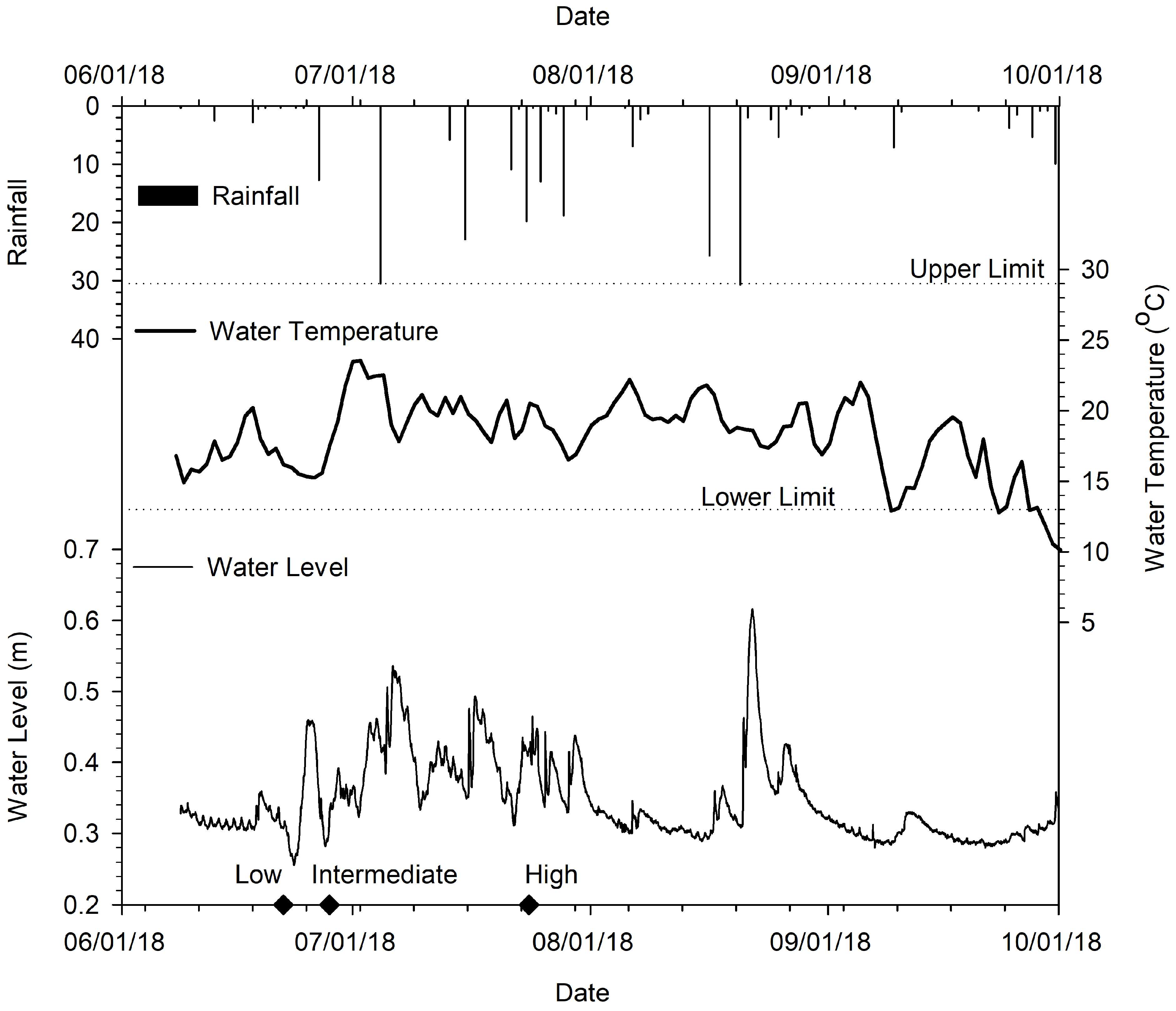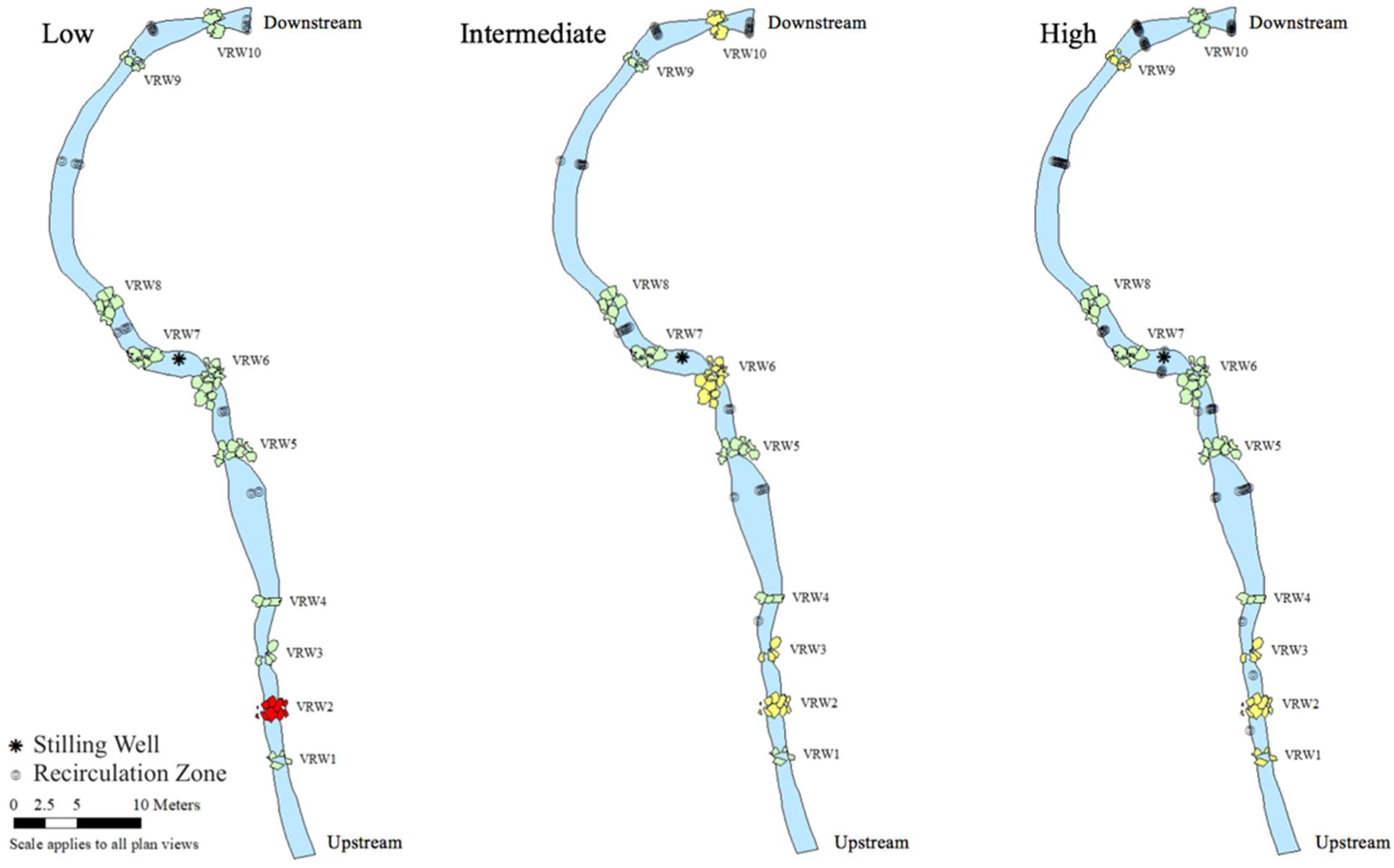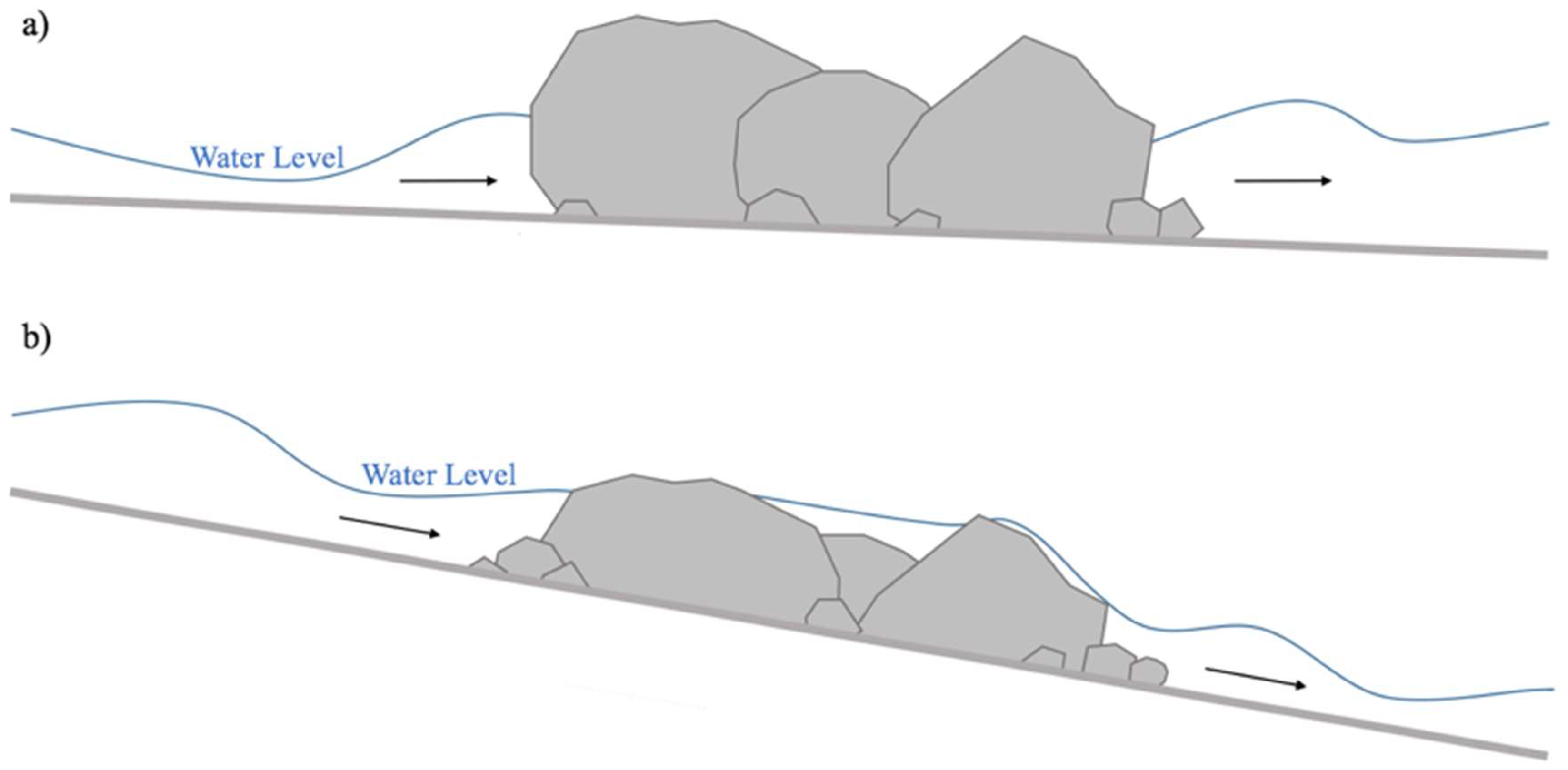Balancing Physical Channel Stability and Aquatic Ecological Function through River Restoration
Abstract
1. Introduction
2. Study Site
3. Methods
4. Results
5. Discussion
5.1. Critical VRW Design Components for Suitable Fish Passage
- Gradient;
- Keystone characteristics;
- VRW geometry.
5.1.1. VRW Gradient
5.1.2. Keystone Characteristics
5.1.3. VRW Geometry
Embeddedness
Orifices
Distance between VRWs
5.2. Evaluating VRW Design and Construction for Fish Passage Suitability
6. Conclusions
- increased secondary gradients at VRWs to enhance longitudinal connectivity and active orifice, gap, and over-weir flow pathways;
- a greater number of keystones and larger range of keystone diameters at each VRW to provide opportunities for energy dissipation and various pathways (in terms of shape and size) for fish passage;
- greater keystone embeddedness (particularly at the VRW crest) to enhance the longitudinal connectivity under all water level conditions;
- a greater distance between VRWs (i.e., greater pool length) to provide opportunities for recirculation zones to form and provide locations for fish refuge.
Supplementary Materials
Author Contributions
Funding
Data Availability Statement
Acknowledgments
Conflicts of Interest
References
- Hawley, R.J.; Macmannis, K.R.; Wooten, M.S. Bed Coarsening, Riffle Shortening, and Channel Enlargement in Urbanizing Watersheds, Northern Kentucky, USA. Geomorphology 2013, 201, 111–126. [Google Scholar] [CrossRef]
- Navratil, O.; Breil, P.; Schmitt, L.; Grospretre, L.; Albert, M.B. Hydrogeomorphic Adjustments of Stream Channel Disturbed by Urban Runoff (Yzeron River Basin, France). J. Hydrol. 2013, 485, 24–36. [Google Scholar] [CrossRef]
- Vietz, G.J.; Sammonds, M.J.; Walsh, C.J.; Fletcher, T.D.; Rutherford, I.D.; Stewardson, M.J. Ecologically Relevant Geomorphic Attributes of Streams Are Impaired by Even Low Levels of Watershed Effective Imperviousness. Geomorphology 2014, 206, 67–78. [Google Scholar] [CrossRef]
- Li, S.; Yang, J.; Ansell, A. Evaluation of Pool-Type Fish Passage with Labyrinth Weirs. Sustainability 2022, 14, 1098. [Google Scholar] [CrossRef]
- Ward, J.V.; Stanford, J.A. Ecological Connectivity in Alluvial River Ecosystems and Its Disruption by Flow Regulation. Regul. Rivers Res. Manag. 1995, 11, 105–119. [Google Scholar] [CrossRef]
- Clarke, S.J.; Bruce-Burgess, L.; Wharton, G. Linking Form and Function: Towards an Eco-Hydromorphic Approach to Sustainable River Restoration. Aquat. Conserv. Mar. Freshw. Ecosyst. 2003, 13, 439–450. [Google Scholar] [CrossRef]
- Jansson, R.; Nilsson, C.; Malmqvist, B. Restoring Freshwater Ecosystems in Riverine Landscapes: The Roles of Connectivity and Recovery Processes. Freshw. Biol. 2007, 52, 589–596. [Google Scholar] [CrossRef]
- Katopodis, C.; Williams, J.G. The Development of Fish Passage Research in a Historical Context. Ecol. Eng. 2012, 48, 8–18. [Google Scholar] [CrossRef]
- Ead, S.A.; Katopodis, C.; Sikora, G.J.; Rajaratnam, N. Flow Regimes and Structure in Pool and Weir Fishways. J. Environ. Eng. Sci. 2004, 3, 379–390. [Google Scholar] [CrossRef]
- Dizabadi, S.; Azimi, A.H. Hydraulic and Turbulence Structure of Triangular Labyrinth Weir-Pool Fishways. River Res. Appl. 2020, 36, 280–295. [Google Scholar] [CrossRef]
- Birnie-Gauvin, K.; Franklin, P.; Wilkes, M.; Aarestrup, K. Moving beyond Fitting Fish into Equations: Progressing the Fish Passage Debate in the Anthropocene. Aquat. Conserv. Mar. Freshw. Ecosyst. 2019, 29, 1095–1105. [Google Scholar] [CrossRef]
- Thomas, D.B.; Abt, S.R.; Mussetter, R.A.; Harvey, M.D. A Design Procedure for Sizing Step-Pool Structures. Joint Conference on Water Resource Engineering and Water Resources Planning and Management 2000, Minneapolis, MN, USA, 30 July–2 August 2000; 2012; pp. 1–10. [Google Scholar] [CrossRef]
- Silva, A.T.; Lucas, M.C.; Castro-Santos, T.; Katopodis, C.; Baumgartner, L.J.; Thiem, J.D.; Aarestrup, K.; Pompeu, P.S.; O’Brien, G.C.; Braun, D.C.; et al. The Future of Fish Passage Science, Engineering, and Practice. Fish Fish. 2018, 19, 340–362. [Google Scholar] [CrossRef]
- Baki, A.B.M.; Zhu, D.Z.; Harwood, A.; Lewis, A.; Healey, K. Hydraulic Design Aspects of Rock-Weir Fishways with Notch for Habitat Connectivity. J. Ecohydraulics 2020, 5, 94–109. [Google Scholar] [CrossRef]
- Baki, A.B.M.; Zhu, D.Z.; Harwood, A.; Lewis, A.; Healey, K. Rock-Weir Fishway I: Flow Regimes and Hydraulic Characteristics. J. Ecohydraulics 2017, 2, 122–141. [Google Scholar] [CrossRef]
- Keller, R.J.; Peterken, C.J.; Berghuis, A.P. Design and Assessment of Weirs for Fish Passage under Drowned Conditions. Ecol. Eng. 2012, 48, 61–69. [Google Scholar] [CrossRef]
- Lucas, M.; Baras, E. Migration of Freshwater Fishes; John Wiley & Sons: Hoboken, NJ, USA, 2008; ISBN 978-0-470-99964-6. [Google Scholar]
- Bice, C.M.; Zampatti, B.P.; Mallen-Cooper, M. Paired Hydraulically Distinct Vertical-Slot Fishways Provide Complementary Fish Passage at an Estuarine Barrier. Ecol. Eng. 2017, 98, 246–256. [Google Scholar] [CrossRef]
- Romão, F.; Branco, P.; Quaresma, A.L.; Amaral, S.D.; Pinheiro, A.N. Effectiveness of a Multi-Slot Vertical Slot Fishway versus a Standard Vertical Slot Fishway for Potamodromous Cyprinids. Hydrobiologia 2018, 816, 153–163. [Google Scholar] [CrossRef]
- Zhang, G.; Chanson, H. Three-Dimensional Numerical Simulations of Smooth, Asymmetrically Roughened, and Baffled Culverts for Upstream Passage of Small-Bodied Fish. River Res. Appl. 2018, 34, 957–964. [Google Scholar] [CrossRef]
- Silva, A.T.; Katopodis, C.; Santos, J.M.; Ferreira, M.T.; Pinheiro, A.N. Cyprinid Swimming Behaviour in Response to Turbulent Flow. Ecol. Eng. 2012, 44, 314–328. [Google Scholar] [CrossRef]
- Dodd, J.R.; Cowx, I.G.; Bolland, J.D. Efficiency of a Nature-like Bypass Channel for Restoring Longitudinal Connectivity for a River-Resident Population of Brown Trout. J. Environ. Manag. 2017, 204, 318–326. [Google Scholar] [CrossRef]
- Larinier, M. Fish Passage through Culverts, Rock Weirs and Estuarine Obstructions. Bull. Fr. Pêche Piscic. 2002, 364, 119–134. [Google Scholar] [CrossRef]
- East Holland Subwatershed Plan; LSRCA (Lake Simcoe Region Conservation Authority): Newmarket, Canada, 2010.
- Wolman, M.G. A Method of Sampling Coarse River-Bed Material. Eos Trans. Am. Geophys. Union 1954, 35, 951–956. [Google Scholar] [CrossRef]
- Newson, M.D.; Newson, C.L. Geomorphology, Ecology and River Channel Habitat: Mesoscale Approaches to Basin-Scale Challenges. Prog. Phys. Geogr. 2000, 24, 195–217. [Google Scholar] [CrossRef]
- Carollo, F.G.; Ferro, V.; Termini, D. Flow Velocity Measurements in Vegetated Channels. J. Hydraul. Eng. 2002, 128, 664–673. [Google Scholar] [CrossRef]
- Katopodis, C.; Gervais, R. Fish Swimming Performance Database and Analysis. Department of Fisheries and Oceans Canada Canadian Science Advisory Secretariat: Winnipeg, Canada, 2016. [Google Scholar]
- Mielhausen, J. Evaluating Fish Passage Effectiveness Through a Sequence of Modified Vortex Rock Weirs; University of Guelph: Guelph, ON, Canada, 2019. [Google Scholar]
- Baki, A.B.M.; Azimi, A.H. Hydraulics and Design of Fishways II: Vertical-Slot and Rock-Weir Fishways. J. Ecohydraulics 2021, 1–13. [Google Scholar] [CrossRef]
- Williams, J.G.; Armstrong, G.; Katopodis, C.; Larinier, M.; Travade, F. Thinking Like a Fish: A Key Ingredient for Development of Effective Fish Passage Facilities at River Obstructions. River Res. Appl. 2012, 28, 407–417. [Google Scholar] [CrossRef]
- Roscoe, D.W.; Hinch, S.G. Effectiveness Monitoring of Fish Passage Facilities: Historical Trends, Geographic Patterns and Future Directions. Fish Fish. 2010, 11, 12–33. [Google Scholar] [CrossRef]
- Doehring, K.; Young, R.G.; McIntosh, A.R.; Doehring, K.; Young, R.G.; McIntosh, A.R. Factors Affecting Juvenile Galaxiid Fish Passage at Culverts. Mar. Freshw. Res. 2011, 62, 38–45. [Google Scholar] [CrossRef]
- Weibel, D.; Peter, A. Effectiveness of Different Types of Block Ramps for Fish Upstream Movement. Aquat. Sci. 2013, 75, 251–260. [Google Scholar] [CrossRef]
- Varyu, D.; Russell, K.; Holburn, E. Quantitative Evaluation of Rock Weir Field Performance. In Proceedings of the World Environmental and Water Resources Congress 2009, Kansas City, MO, USA, 12 May 2009; American Society of Civil Engineers: Reston, VA, USA; pp. 1–11. [Google Scholar]
- Church, M. Channel Stability: Morphodynamics and the Morphology of Rivers. In Rivers—Physical, Fluvial and Environmental Processes GeoPlanet: Earth and Planetary Sciences; Springer: Cham, Switzerland, 2015; pp. 281–321. ISBN 978-3-319-17718-2. [Google Scholar]
- Kupferschmidt, C.; Zhu, D.Z. Physical Modelling of Pool and Weir Fishways with Rock Weirs. River Res. Appl. 2017, 33, 1130–1142. [Google Scholar] [CrossRef]
- Martens, K.D.; Connolly, P.J. Effectiveness of a Redesigned Water Diversion Using Rock Vortex Weirs to Enhance Longitudinal Connectivity for Small Salmonids. North Am. J. Fish. Manag. 2010, 30, 1544–1552. [Google Scholar] [CrossRef]
- Hu, Q.; Wang, X.; Zhu, L.; Du, S.; He, F. Effect of Parameters of Pool Geometry on Flow Structure in Nature-like Fishway. Int. J. Environ. Res. Public. Health 2022, 19, 9389. [Google Scholar] [CrossRef]
- Wang, Z.; Melching, C.S.; Duan, X.; Yu, G. Ecological and Hydraulic Studies of Step-Pool Systems. J. Hydraul. Eng. 2009, 135, 705–717. [Google Scholar] [CrossRef]
- Silva, A.T.; Bermúdez, M.; Santos, J.M.; Rabuñal, J.R.; Puertas, J. Pool-Type Fishway Design for a Potamodromous Cyprinid in the Iberian Peninsula: The Iberian Barbel—Synthesis and Future Directions. Sustainability 2020, 12, 3387. [Google Scholar] [CrossRef]
- Bermúdez, M.; Puertas, J.; Cea, L.; Pena, L.; Balairón, L. Influence of Pool Geometry on the Biological Efficiency of Vertical Slot Fishways. Ecol. Eng. 2010, 36, 1355–1364. [Google Scholar] [CrossRef]
- Knaepkens, G.; Baekelandt, K.; Eens, M. Fish Pass Effectiveness for Bullhead (Cottus Gobio), Perch (Perca Fluviatilis) and Roach (Rutilus Rutilus) in a Regulated Lowland River. Ecol. Freshw. Fish 2006, 15, 20–29. [Google Scholar] [CrossRef]
- Tummers, J.S.; Hudson, S.; Lucas, M.C. Evaluating the Effectiveness of Restoring Longitudinal Connectivity for Stream Fish Communities: Towards a More Holistic Approach. Sci. Total Environ. 2016, 569–570, 850–860. [Google Scholar] [CrossRef]
- Davis, L.; Cockburn, J.; Villard, P.V.; Davis, L.; Cockburn, J.; Villard, P.V. Deploying action cameras to observe fish in shallow, ice-covered streams. J. Freshw. Ecol. 2016, 32, 193–198. [Google Scholar] [CrossRef]







| Genus | Species | Common Name | Adult Length (m) | Burst Swim Speed (m/s) | Preferred Temperature Range (°C) | Vertical Leaping Capability (m) * |
|---|---|---|---|---|---|---|
| Cottus | bairdi | Mottled sculpin | 0.07–0.10 | 0.84 | 18 | 0.35–0.50 |
| Rhinichthys | atralutus | Blacknose dace | 0.07–0.10 | 0.69 | 19–25 | 0.35–0.50 |
| Semotilus | atromaculatus | Creek chub | 0.08–0.20 | 0.44 | 20.8 | 0.40–1.00 |
| Pimephalse | promelas | Fathead minnow | 0.05–0.07 | 0.55 | 23–29 | 0.25–0.35 |
| Culaea | inconstans | Brook Stickleback | 0.04–0.07 | 0.89 ** | 21.3 | 0.25–0.35 |
| VRW | Gradient | % Passability at Low Water Levels | % Passability at Intermediate Water Levels | % Passability at High Water Levels |
|---|---|---|---|---|
| 1 | −0.01 | 100 | 100 | 100 for ≤ 4 species |
| 2 | −0.02 | 0 * | 100 for ≤ 4 species | 100 for ≤ 4 species |
| 3 | −0.02 | 100 | 100 for ≤ 4 species | 100 for ≤ 4 species |
| 4 | −0.05 | 100 | 100 for ≤ 4 species | 100 |
| 5 | −0.10 | 100 | 100 | 100 |
| 6 | −0.08 | 100 | 100 for ≤ 4 species | 100 |
| 7 | −0.14 | 100 | 100 | 100 |
| 8 | −0.09 | 100 | 100 | 100 |
| 9 | −0.05 | 100 | 100 | 100 for ≤ 4 species |
| 10 | −0.06 | 100 | 100 for ≤ 4 species | 100 |
| Pool | Length (m) | Pool Depth (m) * | Total Number of Locations for Fish Refuge under All Water Level Conditions |
|---|---|---|---|
| 1 | 7.40 | 0.14 | 0 |
| 2 | 2.30 | 0.10 | 1 |
| 3 | 2.40 | 0.11 | 1 |
| 4 | 3.60 | 0.11 | 1 |
| 5 | 11.20 | 0.17 | 34 |
| 6 | 3.90 | 0.13 | 15 |
| 7 | 3.80 | 0.20 | 5 |
| 8 | 2.50 | 0.16 | 20 |
| 9 | 20.70 | 0.25 | 23 |
| 10 | 5.90 | 0.20 | 26 |
| 11 | 2.40 | 0.25 | 19 |
| VRW | VRW Crest Width (m) | # Keystones | Range of Keystone Sizes (m) | % Passability at Low Water Levels | % Passability at Intermediate Water Levels | % Passability at High Water Levels |
|---|---|---|---|---|---|---|
| 1 | 1.9 | 5 | 0.2–1.8 | 100 | 100 | 100 for ≤ 4 species |
| 2 | 3.1 | 8 | 0.4–1.1 | 0 * | 100 for ≤ 4 species | 100 for ≤ 4 species |
| 3 | 2.2 | 4 | 0.6–0.8 | 100 | 100 | 100 for ≤ 4 species |
| 4 | 2.4 | 3 | 0.6–1.3 | 100 | 100 for ≤ 4 species | 100 |
| 5 | 3.6 | 9 | 0.5–1.0 | 100 | 100 | 100 |
| 6 | 3.5 | 9 | 0.6–1.1 | 100 | 100 for ≤ 4 species | 100 |
| 7 | 3.3 | 8 | 0.2–1.1 | 100 | 100 | 100 |
| 8 | 3.5 | 9 | 0.2–1.3 | 100 | 100 | 100 |
| 9 | 2.7 | 6 | 0.3–0.7 | 100 | 100 | 100 for ≤ 4 species |
| 10 | 2.5 | 7 | 0.2–10 | 100 | 100 for ≤ 4 species | 100 |
Disclaimer/Publisher’s Note: The statements, opinions and data contained in all publications are solely those of the individual author(s) and contributor(s) and not of MDPI and/or the editor(s). MDPI and/or the editor(s) disclaim responsibility for any injury to people or property resulting from any ideas, methods, instructions or products referred to in the content. |
© 2023 by the authors. Licensee MDPI, Basel, Switzerland. This article is an open access article distributed under the terms and conditions of the Creative Commons Attribution (CC BY) license (https://creativecommons.org/licenses/by/4.0/).
Share and Cite
Mielhausen, J.; Cockburn, J.M.H.; Villard, P.V.; Baril, A.-M. Balancing Physical Channel Stability and Aquatic Ecological Function through River Restoration. Water 2023, 15, 1799. https://doi.org/10.3390/w15091799
Mielhausen J, Cockburn JMH, Villard PV, Baril A-M. Balancing Physical Channel Stability and Aquatic Ecological Function through River Restoration. Water. 2023; 15(9):1799. https://doi.org/10.3390/w15091799
Chicago/Turabian StyleMielhausen, Josie, Jaclyn M. H. Cockburn, Paul V. Villard, and André-Marcel Baril. 2023. "Balancing Physical Channel Stability and Aquatic Ecological Function through River Restoration" Water 15, no. 9: 1799. https://doi.org/10.3390/w15091799
APA StyleMielhausen, J., Cockburn, J. M. H., Villard, P. V., & Baril, A.-M. (2023). Balancing Physical Channel Stability and Aquatic Ecological Function through River Restoration. Water, 15(9), 1799. https://doi.org/10.3390/w15091799






